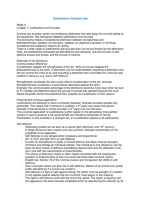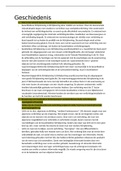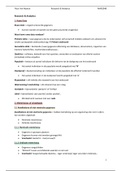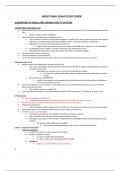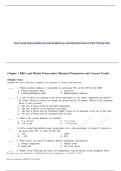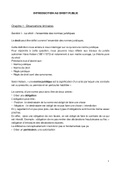Summary International Strategy (IS)
Content
Page
Introduction 2
§1 Theoretical foundations of IS 3
§2 Where do MNE’s invest 7
§3 How do MNE’s invest abroad 11
§4 When do MNE’s invest abroad 15
§5 Multinationality and performance 20
The build-up of this summary is as follow:
o §1 – Theoretical foundations of IS + Why do MNE’s set up foreign subsidiaries/invest abroad?
o §2 – Where do MNE’s set up foreign subsidiaries/invest abroad and what are the factors
driving this decision?
o §3 – When do MNE’s set up foreign subsidiaries/invest abroad and what are the advantages
of being an early or late mover?
o §4 – How do MNE’s set up foreign subsidiaries/invest abroad and what are the factors driving
this decision?
o §5 – What is the MNE’s optimal balance between multinationality and performance,
accounting for the key probabilities affecting this relation?
,Introduction
International strategies refer to all strategic actions and decisions related to a company expanding its
operations and/or activities into a foreign country
Different frameworks can be used to analyze strategic-decision-making. These are discussed in TIB:
- Liability of foreignness (LOF): the cost of doing business abroad (Hymer, 1976). According to
Zaheer (1995) there are four elements to it: spatial distance, unfamiliarity, host-country
restrictions (lack of legitimacy) and home-country restrictions.
- Transaction cost theory (Coase, Williamson): market imperfections generate transaction costs.
- Internalization theory (Buckley, Casson, Hennart, Rugman): a market in an intermediate good
will be internalized if the benefits outweigh the (transaction) costs. Rugman specifically
focused on FSA’s.
- Eclectic paradigm/OLI model (Dunning): it is a further development of the internalization
theory and consists of three parts: ownership advantages/FSA’s, location advantages/CSA’s,
internalization. Based on this framework he developed four foreign direct investment (FDI)
motives: natural resource-seeking, market-seeking, efficiency-seeking, and strategic asset-
seeking.
- Internationalization theory/Uppsala model (Johanson & Vahlne, 1977): incremental expansion
of MNE’s
Other frameworks that can be used and will be discussed in §1 are: Porter’s (1986) global value chain,
Ghemawat’s (2008) AAA-strategies, Bartlett & Ghoshal’s (1989) integration-responsiveness framework
and Rugman & Verbeke’s (1992) transnational solution.
This course takes a strategic management perspective in exploring the strategies of MNE’s to create
value through resource-based and institution-based views:
- The resource-based view (Barney, 1990’s) is about valuable, rare, imitable, and non-
substitutable resources (both tangible and intangible). Capabilities are firm-specific abilities to
recombine resources.
- The institution-based view (North, Scott, Peng, 2000’s) is about institutions which are the
humanly devised constraints that structure political, economic and social interaction. They
consist of informal constraints and formal rules.
Other important definitions are:
- Endogenous: those factors within the control of the company (internal), e.g. location and
supply
- Exogenous: those factors out of control of the company (external), e.g. taxes, but also Covid-
19
2
, §1 Theoretical foundations of IS
Lecture 1 (30-3), Knowledge Clip 1.1-1.4 + 2.3, Article 1.1-1.4
The reason why MNE’s exist and why they set up foreign subsidiaries/invest abroad is globalization.
Globalization is internationalization and functional integration (e.g. integration of economic activities
across countries such as the IMF and the UN). Globalization makes countries come closer to each other.
The main economic expression of globalization is international trade. Nowadays scholars struggle with
three questions about globalization:
1. Is globalization real? Hyperglobalists believe that today’s global economy is genuinely
borderless. Sceptics believe that globalization is a myth. Some believe MNE’s are regional in
nature (Rugman & Verbeke, 2004; TIB) or that we are only semi-globalized (Ghemawat, 2001;
TIB).
2. Is globalization dead? Protests against TTIP and CETA, but also the Brexit and America first.
3. Is globalization good? In terms of democracy, environment, instability, culture and equality.
In knowledge clip 2.3 it is argued that there are two opposing view on how the world is changing:
- Friedman: the world is flat, there are no or very little differences between countries.
- Florida: the world is spiky, while globalization has changed the economic playing field, but
hasn’t leveled it.
MNE’s activities are displayed in the global value chain and MNE’s form decisions based on this global
value chain. Porter (1986) focuses on industries and proposes four strategic options based on
configuration and coordination. Ghemawat (2008) however focuses on countries and proposes the
AAA-framework. Cantwell et al. (2010) examine the co-evolution of MNE activities and institutions.
According to Bartlett & Ghoshal (1989) MNE’s follow different strategies in response to pressures from
global integration and local responsiveness. Rugman & Verbeke (1992) expand on this theory and
include the transaction cost theory.
§1.1 Global value chain (GVC)
The activities in the global value chain represent
a smiling curve, meaning that those activities that
add the most value (innovation systems such as
R&D (pre-production intangibles) and marketing
& sales (post-production intangibles)) will be
done in the home country, while those activities
that add the less value (production networks
(tangibles) such as logistics, production,
distributions) will be done in foreign countries.
The example of Apple is given.
The complexity of MNE’s GVC’s arise from geographic and organizational dispersion of business
activities: within the MNE’s boundaries (subsidiaries) and outside the MNE’s boundaries (suppliers,
universities, research institutions). This all results in high coordination costs.
The key decision drivers when making decisions about the GVC activities are firm-specific advantages
(FSA’s), country-specific advantages (CSA’s) and internalization advantages (TIB: Dunning, 1998/2009).
FSA’s are not solely developed in the home country and may be transferred with the MNE network,
CSA’s (also in a specific host country) can contribute to the development of new FSA’s and
internalization advantages depend on a company’s transactional FSA’s to operate foreign subsidiaries.
3
Content
Page
Introduction 2
§1 Theoretical foundations of IS 3
§2 Where do MNE’s invest 7
§3 How do MNE’s invest abroad 11
§4 When do MNE’s invest abroad 15
§5 Multinationality and performance 20
The build-up of this summary is as follow:
o §1 – Theoretical foundations of IS + Why do MNE’s set up foreign subsidiaries/invest abroad?
o §2 – Where do MNE’s set up foreign subsidiaries/invest abroad and what are the factors
driving this decision?
o §3 – When do MNE’s set up foreign subsidiaries/invest abroad and what are the advantages
of being an early or late mover?
o §4 – How do MNE’s set up foreign subsidiaries/invest abroad and what are the factors driving
this decision?
o §5 – What is the MNE’s optimal balance between multinationality and performance,
accounting for the key probabilities affecting this relation?
,Introduction
International strategies refer to all strategic actions and decisions related to a company expanding its
operations and/or activities into a foreign country
Different frameworks can be used to analyze strategic-decision-making. These are discussed in TIB:
- Liability of foreignness (LOF): the cost of doing business abroad (Hymer, 1976). According to
Zaheer (1995) there are four elements to it: spatial distance, unfamiliarity, host-country
restrictions (lack of legitimacy) and home-country restrictions.
- Transaction cost theory (Coase, Williamson): market imperfections generate transaction costs.
- Internalization theory (Buckley, Casson, Hennart, Rugman): a market in an intermediate good
will be internalized if the benefits outweigh the (transaction) costs. Rugman specifically
focused on FSA’s.
- Eclectic paradigm/OLI model (Dunning): it is a further development of the internalization
theory and consists of three parts: ownership advantages/FSA’s, location advantages/CSA’s,
internalization. Based on this framework he developed four foreign direct investment (FDI)
motives: natural resource-seeking, market-seeking, efficiency-seeking, and strategic asset-
seeking.
- Internationalization theory/Uppsala model (Johanson & Vahlne, 1977): incremental expansion
of MNE’s
Other frameworks that can be used and will be discussed in §1 are: Porter’s (1986) global value chain,
Ghemawat’s (2008) AAA-strategies, Bartlett & Ghoshal’s (1989) integration-responsiveness framework
and Rugman & Verbeke’s (1992) transnational solution.
This course takes a strategic management perspective in exploring the strategies of MNE’s to create
value through resource-based and institution-based views:
- The resource-based view (Barney, 1990’s) is about valuable, rare, imitable, and non-
substitutable resources (both tangible and intangible). Capabilities are firm-specific abilities to
recombine resources.
- The institution-based view (North, Scott, Peng, 2000’s) is about institutions which are the
humanly devised constraints that structure political, economic and social interaction. They
consist of informal constraints and formal rules.
Other important definitions are:
- Endogenous: those factors within the control of the company (internal), e.g. location and
supply
- Exogenous: those factors out of control of the company (external), e.g. taxes, but also Covid-
19
2
, §1 Theoretical foundations of IS
Lecture 1 (30-3), Knowledge Clip 1.1-1.4 + 2.3, Article 1.1-1.4
The reason why MNE’s exist and why they set up foreign subsidiaries/invest abroad is globalization.
Globalization is internationalization and functional integration (e.g. integration of economic activities
across countries such as the IMF and the UN). Globalization makes countries come closer to each other.
The main economic expression of globalization is international trade. Nowadays scholars struggle with
three questions about globalization:
1. Is globalization real? Hyperglobalists believe that today’s global economy is genuinely
borderless. Sceptics believe that globalization is a myth. Some believe MNE’s are regional in
nature (Rugman & Verbeke, 2004; TIB) or that we are only semi-globalized (Ghemawat, 2001;
TIB).
2. Is globalization dead? Protests against TTIP and CETA, but also the Brexit and America first.
3. Is globalization good? In terms of democracy, environment, instability, culture and equality.
In knowledge clip 2.3 it is argued that there are two opposing view on how the world is changing:
- Friedman: the world is flat, there are no or very little differences between countries.
- Florida: the world is spiky, while globalization has changed the economic playing field, but
hasn’t leveled it.
MNE’s activities are displayed in the global value chain and MNE’s form decisions based on this global
value chain. Porter (1986) focuses on industries and proposes four strategic options based on
configuration and coordination. Ghemawat (2008) however focuses on countries and proposes the
AAA-framework. Cantwell et al. (2010) examine the co-evolution of MNE activities and institutions.
According to Bartlett & Ghoshal (1989) MNE’s follow different strategies in response to pressures from
global integration and local responsiveness. Rugman & Verbeke (1992) expand on this theory and
include the transaction cost theory.
§1.1 Global value chain (GVC)
The activities in the global value chain represent
a smiling curve, meaning that those activities that
add the most value (innovation systems such as
R&D (pre-production intangibles) and marketing
& sales (post-production intangibles)) will be
done in the home country, while those activities
that add the less value (production networks
(tangibles) such as logistics, production,
distributions) will be done in foreign countries.
The example of Apple is given.
The complexity of MNE’s GVC’s arise from geographic and organizational dispersion of business
activities: within the MNE’s boundaries (subsidiaries) and outside the MNE’s boundaries (suppliers,
universities, research institutions). This all results in high coordination costs.
The key decision drivers when making decisions about the GVC activities are firm-specific advantages
(FSA’s), country-specific advantages (CSA’s) and internalization advantages (TIB: Dunning, 1998/2009).
FSA’s are not solely developed in the home country and may be transferred with the MNE network,
CSA’s (also in a specific host country) can contribute to the development of new FSA’s and
internalization advantages depend on a company’s transactional FSA’s to operate foreign subsidiaries.
3

